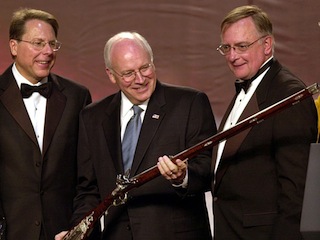What do a 1995 attack on a Japanese subway system, the crumbling security at Libyan military bases and al-Qaeda’s putative ambitions to create a “dirty bomb” have in common? They all sound scary, and therefore all fit (albeit with no small handwaving) into the latest narrative of the “threat” of Syria.
 With the ink barely dried on the latest calls for NATO intervention in Syria, the Washington Post has emerged with an article brimming with unrelated factoids, most of which have not even a cursory relation to Syria, arguing that the nation’s WMD arsenal is something to be greatly feared.
With the ink barely dried on the latest calls for NATO intervention in Syria, the Washington Post has emerged with an article brimming with unrelated factoids, most of which have not even a cursory relation to Syria, arguing that the nation’s WMD arsenal is something to be greatly feared.
The timing is brazen, being paired with another Washington Post article on rebel calls for NATO to attack the nation. It also comes just days after Dick Cheney, busily parlaying his book and the media’s notoriously short term memory into a restoration from hawkish caricature to “gravitas” wielding elder statesman, lamented his inability to start a war in Syria.
The fast and loose effort to cram anything and everything into the article is equally telling, as vague mentions of “dirty bombs” using fuel rods that Syria does not possess in particularly useful numbers combine with theories about nerve gas somehow polluting the world’s drinking water and food playing equal roles in a familiar game: frightening the public about an illusory enemy on the eve of dropping a bomb about the administration’s intentions to drop literal bombs on them.
That such a fanciful tale worked in the past was shameful enough. That it is being tried again while the occupation of the last “WMD threat” is still going on is nothing short of shocking.





Shocked? No. Too many lies that have led to too many wars that have led to too many deaths. I am no longer shocked at what our government does. I am only shamed by the blatant aggressive actions we take under the guise of protecting peace. I am sickened by the fact that so many of our citizens view these actions as just and necessary and hold the military up as heroic. We ARE a nation of mislead sheep and we WILL suffer for it.
Problem is, in the rise and fall of Empire USA, Syria is not dealing with a rational enemy, for like a wounded elephant is bankrupt and war demoralized USA in its last days.
Surely wisdom calls out for Syria to kick democracy into high gear, for doing nothing about the Golan Highs and taking a middle of the road approach toward the West, this is the same blind alley that caused Gaddafi to be demoted from king to a now hunted terrorist.